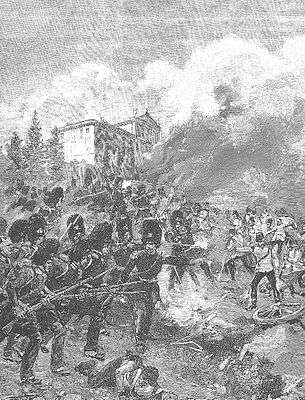Battle of Custoza (1848)
| Battle of Custoza | |||||||
|---|---|---|---|---|---|---|---|
| Part of the First Italian War of Independence | |||||||
 | |||||||
| |||||||
| Belligerents | |||||||
|
|
| ||||||
| Commanders and leaders | |||||||
|
|
| ||||||
| Strength | |||||||
| 33,000 | 22,000 | ||||||
| Casualties and losses | |||||||
|
23–26 July:[1] (26–27 July at Volta):[1] |
23–26 July:[2] (26–27 July at Volta):[2] | ||||||
The Battle of Custoza was fought on July 24 and 25, 1848 during the First Italian War of Independence between the armies of the Austrian Empire, commanded by Field Marshal Radetzky, and the Kingdom of Sardinia, led by King Charles Albert of Sardinia-Piedmont.
Background
In March 1848, the city of Milan launched an uprising against Austrian occupation. Charles Albert supported the Milanese revolt and declared war on Austria. Venice also declared its independence from Austria. The Austrian Field Marshal Radetzky withdrew his forces from Milan to the defensive positions based on the four fortresses known as the Quadrilateral: Verona, Mantua, Peschiera, and Legnago. The Piedmontese took Peschiera after a short siege, but Radetzky received substantial reinforcements.
The battle
Around the 15th July, the Piedmontese Army was widely dispersed on the war theater, from the Rivoli plateau on the north to Governolo on the south. Marshal Radetzki attacked, on July 23, the Piedmontese II Corps (commanded by General Ettore Gerbaix De Sonnaz), and forced it to retire first before Peschiera and then, after another successful attack on the 24th, behind the river Mincio, separating the Piedmontese Army in two.[3]
The Piedmontese High Command reacted slowly and uncertainly to the news coming from the north, and eventually it was decided to attack the Austrian army in the rear towards the village of Staffalo, with the bulk of the I Corps (led by General Eusebio Bava); the attack, begun in the afternoon of the 24th, was successful and the single brigade which covered this area was forced to retreat. However, this lulled the Sardinian commanders into a false sense of complacency, and spurred Radetzki to stop his advance beyond the Mincio and march on these enemy forces.[4]
For the 25th, the Piedmontese were ordered to attack the enemy further in the area, while the II Corps was instructed to support the attack from the Mincio (however General De Sonnaz refused to obey the order, claiming that his troops were too tired); but what was supposed to be an offensive soon turned into a desperate battle to hold the advancing enemy. For the whole day, the outnumbered Piedmontese were subjected by attacks by two Austrian army corps, and by the end of the day the whole line had been forced to move back; however, the retreat was done in an orderly way and with the men fighting.[5]
The aftermath
While not a total victory (in fact, the Austrians had suffered higher losses than the Piedmontese, and all the major Piedmontese units kept their cohesion and their equipment), the spirit of King Charles Albert and of his generals was all but broken; although initially intending to counterattack, the retreat behind the Mincio would only stop at Milano; after a small battle at the outskirts of the city, an armistice (originally of six weeks, then prorogued) was signed and the Piedmontese Army retreated within the borders of the Kingdom of Sardinia.
The attempt to renew the war effort the next year resulted in another victory for Radetzky and the effective end of the First Italian War of Independence; the Austrian Marshal returned all the rebellious provinces to Austrian rule.
References
- 1 2 Aus der Kaiserlich Königlichen Hof- und Staatsdruckerei (1848). Der Feldzug der österreichischen Armee in Italien im Jahre 1848 III.Abschnitt. Mailand. pp. 119, 122 and 129.
- 1 2 Berkeley, George Fitz-Hardinge (1940). Italy in the Making Vol.III. Cambridge University Press. p. 383.
- ↑ Pieri, p. 236-41
- ↑ Pieri, p. 241-3
- ↑ Pieri, p. 243-7
- Battle of Custoza (1848), Encyclopædia Britannica
Sources
- Pieri, Piero (1962). Storia militare del Risorgimento: guerre e insurrezioni. Torino: Giulio Einaudi.
Coordinates: 45°22′44″N 10°47′45″E / 45.37889°N 10.79583°E